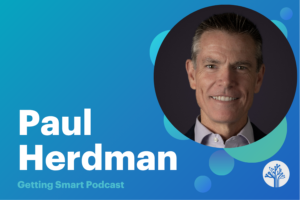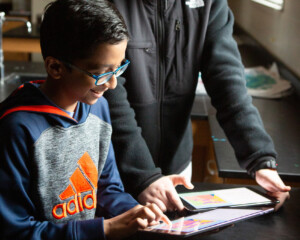Working Your Way Out of an EdTech Mess

Last month I read a bunch of district EdTech plans from forward leaning schools and districts. While I appreciate their initiative, there were three common problems with goals, change strategies and infrastructure.
With more than a computer for every two students, the country is beyond the halfway point in the #ShiftToDigital, a historic transition in how people learn. The problems I spotted are different than those faced five years ago reflecting a good deal of progress and some lessons learned.
Following is a recap of some new problems, each addressed with some quick tips and resources.
1. Lacking a narrative
Most plans were just not very inspiring; they lacked vision and a case for change. Plans should answer a basic question: Why should a student, teacher or parent choose this school (or district)?
Some plans talked about preparing “confident, resilient and successful global citizens” and about engaging learners and creating personal learning pathways. But most goals were formulaic. For example, “4% increase per year in reading scores” (and they meant 4 percentage point increase per year). None of the documents connected their plans to the purpose of education.
Quick tips:
- Hold a community conversation about your academic goals. Ask parents, teachers and community members what they think young people should know and be able to do. You’ll probably find some consensus about broader aims.
- Consider the learner-centered language of Education Reimagined.
- Build a compelling case for how new learning models will improve conditions and opportunities for teachers.
For more, see:
- Building Habits of Success and Measuring What Matters
- Improving Conditions & Careers: How Blended Learning Can Improve the Teaching Profession
2. Lacking a coherent change strategy
All of the plans improved student access to technology and discussed blended learning. However, most relied on individual classroom change and didn’t really facilitate new learning sequences. They were blended classroom plans not blended school plans.
There are three problems with this organic bottom-up approach:
- Personalized and competency-based learning are a team sport. If we really want students to have personalized learning experiences and individual learning trajectories, it requires teams of teachers working with a set of academic agreements supported by systems, schedules and structures.
- Like students, teachers deserve blended, personalized and competency-based learning.
- Getting the most out of apps, platforms and devices requires agreements among teacher teams.
The alternative to organic isn’t a top down plan crafted by a few “wise men.” It requires an identification and support for teacher leaders, informed school supports and processes that lead to sound collective decisions.
Quick tips from leading districts:
- Santa Ana: Informed school level plans
- Fulton County: Teacher leader network + supported school plans
- Charlotte-Mecklenburg: Personalized learning + opportunity culture
- Kettle Moraine: Microschools show the way
For more, see:
- Agreement Crafting: 10 Lessons on The Politics of Schooling
- Preparing Teachers For Deeper Learning
- The Micro-School Opportunity
- Helping Chief Academic Officers Make The Shift From Managed Instruction To Personalized Learning
3. Reflected an EdTech mess
Five years ago most high schools had a few Windows labs and most districts were trying to figure out how to boost access. Leaders like Mooresville phased in 1:1 access with $1,000 Apple laptops by dedicating about $250 per year. The iPad craze swept districts in 2012-13, all too often without a well-developed plan.
Chromebooks were quietly introduced at FETC in January 2012. At $500 they cost half as much as the cheapest Apple laptop. Two years later they were $200 and quickly became the device of choice for many districts.
To this rapid device evolution add a patchwork of grants, funding mechanisms and state testing requirements. It left an EdTech mess in many districts. Here are three examples from districts in the same region:
- Abundant mix: The district has placed 7,000 iPads into the hands of every student and teacher in our district. There are 1,100 virtual PCs for access by students, as well as over 400 laptops for our teachers. Our district has embraced a dual platform for our learning environment with virtual PCs in every K‐6 classroom and virtual labs in every school.
- Scarce mix: 1,500 old workstations plus 1,600 mobile devices for 8,000 students with a plan to be 1:1 in 40% of district classrooms in three years.
- Crazy mix: Elementary school of 569 students has a few computers in each classroom, a computer lab and a laptop cart, and 156 iPads. Junior high of 571 students has two Windows computer labs, a laptop cart, 30 iPads, and 37 Surface Pros. High school of 656 students has four Windows computer labs, 29 Apple MacBooks, 300 iPads and 185 Chromebooks.
And that’s just devices; add hundreds of user adopted applications and bring-your-own-device and you have a super complicated environment to support. Corporations wouldn’t tolerate this sort of tech mess but often have the ability to quickly change policies and make capital expenditures. EdLeaders that inherit a tech mess don’t need to fix it overnight, but they should make a plan to get all students in a rational high access environment within three years.
Quick tips:
- Inventory devices and applications in use. Help schools select a model and platform; shift devices to grades/locations that support model choices.
- Encourage schools to work with networks. They can simplify choices (but may require philanthropic support to join).
- Work in phases. Build agreements and investments that move the school/district toward a three year goal of having every student in a coherent, high-access environment.
For more, see:
- Smart Series Guide To EdTech Procurement
- Blended Learning Implementation Guide 3.0
- District Conditions for Scale: A Practical Guide to Scaling Personalized Learning (KnowledgeWorks)
Stay in-the-know with all things EdTech and innovations in learning by signing up to receive the weekly Smart Update. This post includes mentions of a Getting Smart partner. For a full list of partners, affiliate organizations and all other disclosures please see our Partner page.







0 Comments
Leave a Comment
Your email address will not be published. All fields are required.